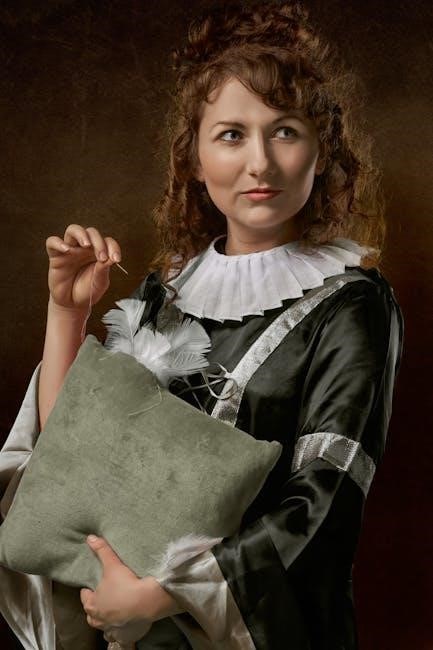This PDF guide provides comprehensive questions and answers for Horacio Quiroga’s “The Feather Pillow,” offering detailed analysis, character insights, and thematic exploration to enhance understanding and study.
1.1 Overview of the Document
The “Feather Pillow Questions and Answers PDF” is a structured guide designed to aid students and educators in analyzing Horacio Quiroga’s short story. It includes multiple-choice, open-response, and evidence-based questions to assess comprehension and critical thinking. Additionally, the document provides detailed character analyses, thematic explorations, and study resources like flashcards for effective preparation. This comprehensive resource is tailored to enhance understanding and facilitate deeper engagement with the story’s elements, making it invaluable for both classroom and independent study settings.
1.2 Importance of the PDF for Study and Analysis
The PDF serves as an essential tool for studying “The Feather Pillow,” offering a structured approach to understanding the story’s complexities. It provides diverse questions that cater to various learning styles, promoting critical thinking and analytical skills. The inclusion of flashcards and discussion prompts further enhances retention and engagement. Educators can utilize this resource to design comprehensive lesson plans, while students benefit from a clear framework for exam preparation and deeper thematic exploration, making it indispensable for academic success.

Background of the Story “The Feather Pillow”
Horacio Quiroga’s “The Feather Pillow” is a chilling tale influenced by his personal struggles and literary mastery, set in a remote, eerie environment that amplifies its dark themes.
2.1 Author Horacio Quiroga and His Literary Style
Horacio Quiroga, a master of the short story, is known for his vivid and haunting narratives. His writing often explores themes of life, death, and survival, heavily influenced by his personal experiences. In “The Feather Pillow,” Quiroga crafts a chilling atmosphere, blending psychological tension with supernatural elements. His literary style is characterized by simplicity, emotional depth, and a focus on the human condition, making his stories both unsettling and thought-provoking. This approach has solidified his place in Latin American literature.
2.2 Historical Context and Themes in the Story
Set in early 20th-century Uruguay, “The Feather Pillow” reflects Quiroga’s fascination with isolation and the supernatural. The story explores themes of marriage dynamics, psychological decay, and the blurred lines between reality and horror. Quiroga’s personal experiences with loss and isolation deeply influenced these themes, creating a haunting narrative that critiques societal norms and delves into the darker aspects of human relationships. The historical context adds depth to the story’s eerie atmosphere and timeless moral dilemmas.

Plot Summary and Key Events
The story revolves around Alicia, a young bride, and her husband Jordan, focusing on her mysterious feather pillow. Alicia’s health declines, and she discovers a creature emerging from the pillow, leading to her tragic death, highlighting the supernatural horror elements central to the narrative.
3.1 The Young Bride and Her Struggles
Alicia, the young bride, faces a life of isolation and loneliness in her marriage to Jordan. Her health begins to deteriorate mysteriously, and she experiences unsettling sensations tied to the feather pillow. Despite her struggles, Jordan remains indifferent, leaving Alicia feeling neglected and vulnerable. Her fears and physical decline escalate, setting the stage for the supernatural horror that unfolds, as the pillow becomes a central element in her tragic fate.
3.2 The Role of the Feather Pillow in the Story
The feather pillow serves as a central and ominous element in the story, symbolizing deception and horror. It is revealed that a creature inhabits the pillow, feeding on Alicia’s blood. This discovery explains her mysterious illness and eventual death. The pillow’s presence heightens the supernatural tension and underscores the themes of isolation and tragedy. Its role is crucial in unraveling the dark fate that befalls Alicia, making it a pivotal object in the narrative’s chilling progression.
3.3 The Tragic Ending and Its Significance
The story concludes with Alicia’s death, revealed to be caused by a creature living in the feather pillow that has been draining her blood. This shocking twist intensifies the horror and underscores the supernatural elements. Alicia’s tragic demise leaves Jordan in despair, highlighting the devastating consequences of the pillow’s dark secret. The ending emphasizes the themes of isolation, the fragility of life, and the unsettling presence of the unknown, leaving a lasting impact on readers.
Comprehension Questions from the PDF
The PDF includes multiple-choice, open-response, and evidence-based questions to assess understanding of the story, its themes, and characters, fostering deep analysis and critical thinking skills.
4.1 Multiple Choice Questions
The PDF features a variety of multiple-choice questions that test readers’ understanding of key plot points, character motivations, and symbolic elements in “The Feather Pillow.” These questions range from identifying basic story details to analyzing complex themes, ensuring a thorough grasp of the narrative. They are designed to engage students and encourage critical thinking about the story’s deeper meanings. Answer keys are provided for self-assessment, making them an invaluable resource for independent study and classroom preparation.
4.2 Open-Response Questions
The PDF includes open-response questions that require readers to analyze and interpret key aspects of “The Feather Pillow.” These questions encourage critical thinking and detailed explanations, covering themes, character dynamics, and symbolic elements. Students are prompted to provide evidence-based answers, fostering a deeper understanding of the story. The questions are designed to prepare learners for essay writing and in-depth literary analysis, with sample answers available to guide students in refining their responses effectively.
4.3 Evidence-Based Questions
The PDF includes evidence-based questions that require students to support their answers with direct references to the text. These questions focus on analyzing specific events, character behaviors, and thematic elements in “The Feather Pillow.” Learners must cite textual evidence to explain phenomena like Alicia’s fears, Jordan’s actions, or the symbolic role of the pillow. This approach ensures a thorough understanding of the story and hones critical analysis skills, preparing students for advanced literary studies and assessments.

Character Analysis
The PDF delves into the psychological depths of Alicia, Jordan, and the mysterious creature, exploring their motivations, fears, and transformations through the story’s dark and haunting narrative.
5.1 Alicia: Her Desires and Fears
Alicia, the young bride, is portrayed as fragile and longing for affection. Her desires for closeness and security are contrasted with her growing fears of isolation and the sinister forces surrounding her. The PDF explores her psychological unraveling, highlighting how her fears manifest into a terrifying reality, ultimately shaping her tragic fate in the story.
5.2 Jordan: His Behavior and Responsibility
Jordan’s behavior in the story is marked by indifference and a lack of emotional support for Alicia. His detachment exacerbates her isolation, making her more vulnerable to the supernatural forces at play. The PDF examines Jordan’s responsibility, or lack thereof, in addressing Alicia’s fears and health struggles, suggesting his negligence contributes to the tragic unfolding of events and the horror that ensues.
5.3 The Creature in the Pillow
The creature within the feather pillow serves as the central supernatural element, symbolizing horror and deception. It preys on Alicia, feeding on her blood and accelerating her demise. The PDF explores how the creature’s presence reflects Alicia’s physical and emotional vulnerability. Its role in the story underscores themes of isolation and betrayal, while also highlighting Jordan’s failure to protect his wife. The creature’s sinister nature amplifies the story’s chilling atmosphere, making it a pivotal element in the tragic narrative.

Themes Explored in the Story
The story delves into themes of life and death, marriage dynamics, and supernatural horror, exploring the darker aspects of human relationships and existential struggles through a chilling narrative.
6.1 Life and Death Struggles
The narrative vividly portrays Alicia’s physical and emotional decline, symbolizing the inevitability of death. Her deteriorating health mirrors the decay of her marriage, highlighting the struggle between existence and extinction. The supernatural element of the feather pillow exacerbates her suffering, creating a haunting metaphor for life’s fragility and death’s inescapability. This theme underscores the futility of human efforts against forces beyond control, resonating deeply with existential dread. The feather pillow itself serves as a harbinger of doom, accelerating Alicia’s demise and symbolizing the darkness that life cannot escape. The interplay between life’s fleeting nature and death’s certainty is central to the story’s unsettling atmosphere.
6.2 Marriage and Relationship Dynamics
The story explores the strained marriage between Alicia and Jordan, highlighting themes of emotional detachment and isolation. Jordan’s indifference to Alicia’s struggles exacerbates her physical and mental decline, reflecting the suffocating nature of their relationship. The feather pillow, symbolic of deception, further isolates Alicia, emphasizing the lack of support in her marriage. This dynamic underscores the broader theme of marital neglect and the psychological impact of unmet emotional needs, mirroring the horror of a loveless union. The narrative portrays marriage as a potential trap, amplifying feelings of loneliness and despair.
6.3 Supernatural Elements and Horror
The story employs supernatural horror through the mysterious creature in the feather pillow, which preys on Alicia, symbolizing an invisible, deadly force. The pillow’s dark secret creates an eerie atmosphere, amplifying tension and fear. Quiroga’s mastery of horror lies in blending the supernatural with psychological dread, as the pillow’s malevolent presence accelerates Alicia’s demise. This chilling narrative leaves readers unsettled, highlighting the terrifying consequences of unseen evils and the fragility of life against supernatural forces.

Symbolism in “The Feather Pillow”
The feather pillow symbolizes deception and hidden dangers, while the house represents isolation and entrapment, reflecting Alicia’s growing sense of dread and inescapable fate.
7.1 The Feather Pillow as a Symbol of Deception
The feather pillow in Horacio Quiroga’s story serves as a potent symbol of deception. Its innocent appearance hides a dark secret: a creature that slowly drains Alicia’s life. The pillow, a common household item, lulls both Alicia and Jordan into a false sense of security, masking the horror within. This deception mirrors the subtle, insidious nature of the creature itself, emphasizing how outward normalcy can conceal lethal truths. The pillow’s role underscores the theme of hidden dangers and betrayal in the narrative.
7.2 The House as a Symbol of Isolation
The house in “The Feather Pillow” symbolizes isolation, both physically and emotionally. Its remote location cuts Alicia off from the outside world, heightening her loneliness and vulnerability. The lack of visitors or external support emphasizes her confinement, mirroring her marital isolation. The house’s emptiness and quiet amplify the eerie atmosphere, allowing the supernatural events to unfold uninterrupted. This isolation not only underscores Alicia’s despair but also serves as a backdrop for the horror, trapping her in a world of dread and deception.

Discussion Questions for Deep Analysis
How does the story’s atmosphere contribute to its horror elements?
What motivates Jordan’s behavior toward Alicia?
How does the setting impact the narrative’s tension and isolation?
8.1 Atmospheric Elements in the Story
The story’s atmosphere is crafted through vivid descriptions of the isolated house and Alicia’s eerie surroundings, creating a sense of dread and foreboding. The dimly lit rooms and oppressive silence heighten the tension, immersing readers in Alicia’s terrifying reality. The feather pillow itself serves as a symbol of the encroaching horror, its presence subtly yet relentlessly contributing to the oppressive mood. These elements collectively build a chilling environment that underscores the story’s dark themes and tragic outcome.
8.2 Moral and Ethical Implications
The story raises profound moral questions about honesty, responsibility, and compassion. Jordan’s failure to address Alicia’s suffering highlights ethical dilemmas in relationships, questioning the duty of care between partners. The creature’s presence symbolizes the consequences of neglect, provoking reflection on moral accountability. These elements challenge readers to consider the ethical implications of inaction and deception, adding depth to the narrative’s horror and tragedy.
8.3 The Role of Setting in the Narrative
The isolated house in “The Feather Pillow” serves as a central element, creating a claustrophobic and eerie atmosphere. Its remote location amplifies the tension and Alicia’s sense of entrapment, mirroring her deteriorating health and marriage. The confined space heightens the supernatural horror, as the feather pillow becomes a symbol of both comfort and dread. The setting effectively underscores the themes of isolation and the inescapability of the couple’s dark reality, enhancing the story’s chilling impact.

Study Resources and Flashcards
Utilize Quizlet flashcards for key terms and concepts from “The Feather Pillow.” Additional practice questions are available to reinforce understanding and prepare for assessments effectively.
9.1 Quizlet Flashcards for Key Terms
Enhance your study session with Quizlet flashcards tailored for “The Feather Pillow.” These flashcards cover essential terms, such as the young bride’s initial fears, the eerie house description, and Alicia’s daily routines; They also explore symbolic elements like the pillow’s role and the creature within. By using active recall and self-assessment, students can master key concepts and themes, ensuring a deeper understanding of the story and its complexities for exams or discussions. Regular practice with these flashcards boosts retention and confidence.
9.2 Additional Practice Questions
Supplement your study with extra practice questions designed to deepen your understanding of “The Feather Pillow.” These questions include multiple-choice, open-response, and evidence-based inquiries, aligning with the PDF guide. They target comprehension of key events, character motivations, and thematic elements. Use these questions to assess your grasp of the story’s atmosphere, moral dilemmas, and symbolic details. Regular practice ensures thorough preparation for exams and fosters a deeper connection with the narrative’s complexities and hidden meanings.

Essay Writing Prompts
Explore analytical essays on the story’s atmosphere and comparative analyses with other works, guiding students to delve into themes, literary styles, and the deeper message of “The Feather Pillow.”
10.1 Analytical Essay on the Story’s Atmosphere
Analyzing the atmosphere in “The Feather Pillow” reveals a masterful blend of horror and suspense. Quiroga crafts a chilling, ominous environment through descriptive settings and symbolic elements. The isolated house amplifies the eerie tension, while the feather pillow serves as a haunting, deceptive object. Students can explore how the author’s use of sensory details and psychological depth creates a foreboding mood, drawing readers into Alicia’s terrifying experience. This essay prompt encourages a deep examination of the story’s emotional and atmospheric layers.
10.2 Comparative Analysis with Other Works
Compare “The Feather Pillow” with other literary works in the horror genre, such as Edgar Allan Poe’s “The Tell-Tale Heart” or H.P. Lovecraft’s “The Call of Cthulhu.” Analyze similarities in themes like psychological horror, suspense, and the supernatural. Discuss how Quiroga’s narrative style and use of symbolism differ from or align with these authors. This essay encourages students to explore broader literary traditions and evaluate how Quiroga’s work contributes to the horror genre’s evolution.

Teaching and Learning Strategies
Engage students with interactive activities, such as group discussions and role-playing, to explore themes and characters. Utilize online resources like Quizlet for vocabulary practice and comprehension exercises to enhance understanding and retention of the story’s elements.
11.1 Classroom Activities for the Story
Engage students with interactive activities such as group discussions on themes and character motivations. Assign creative writing tasks, like rewriting the story from Jordan’s perspective or imagining Alicia’s diary entries. Incorporate role-playing to explore dialogue and relationships. Use multimedia presentations to analyze symbols like the feather pillow. Encourage collaborative projects, such as creating a visual timeline of events or designing a book cover. These activities foster deeper understanding and critical thinking while making learning enjoyable and collaborative.
11.2 Tips for Effective Study and Preparation
For effective study, read the story multiple times, highlighting key passages. Take detailed notes on characters, themes, and symbols. Practice answering sample questions to build confidence. Utilize flashcards for vocabulary and concepts. Engage in group discussions to explore different interpretations. Focus on understanding the story’s themes, such as marriage dynamics and supernatural elements. Regularly review the PDF guide to reinforce learning. Set aside dedicated time for analyzing complex sections and reflecting on the narrative’s deeper meanings. Stay organized and create a study schedule to cover all topics thoroughly.
The “Feather Pillow Questions and Answers PDF” offers a comprehensive guide for understanding Horacio Quiroga’s story, providing insightful resources for deeper analysis and appreciation.
12.1 Final Thoughts on the PDF Guide
The “Feather Pillow Questions and Answers PDF” is a valuable resource for students and educators, offering a comprehensive analysis of Horacio Quiroga’s story. It provides detailed questions, insightful answers, and thoughtful discussion prompts, enabling a deeper understanding of the narrative. The guide enhances appreciation for the story’s themes, characters, and literary style, making it an essential tool for academic and personal study. Its structured approach ensures a thorough exploration of the text, fostering critical thinking and analytical skills.
12.2 Encouragement for Further Exploration
Exploring beyond the PDF guide, readers can delve deeper into Horacio Quiroga’s themes and stylistic choices. Analyzing the historical context and comparing “The Feather Pillow” with other works can enrich understanding. Engaging with study resources, such as Quizlet flashcards and additional practice questions, enhances comprehension. Encouraging students to explore the story’s atmospheric elements and moral implications fosters critical thinking and analytical skills, making the learning experience more immersive and rewarding.
